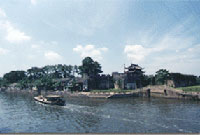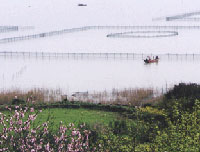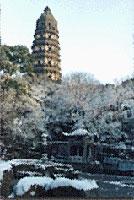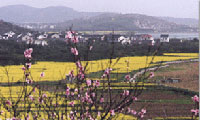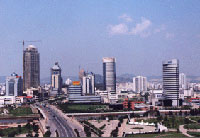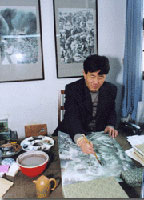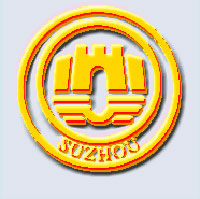History Suzhou
Suzhou was named Wu in the ancient times. First built in 514B.C., the city has a rich history of 2,500 years. The old city has generally retained the unique characteristics of the past. We can see its double-chessboard layout in which "the streets and rivers go side by side, while the water and land routes run in parallel"; We can also see its "3 longitudinal. 3 horizontal and one ring like" river course;
|
|
its small bridges over slowly flowing waters: its "red brick walls with black tiled roofs" and its "historical interests and well-known gardens".Historically this is a remarkable place rich in outstanding talents and natural resources. The city is praised as "the earthly heaven" for its fully developed traditional culture and its scenic gardens.
|
Geography Suzhou
Called Su for short, Suzhou is located in the center of the Yangtze Delta. Its geographic position is 30°47'-32°02'north latitude, 119°55'-121°20' east longitude Adjoining Shanghai City to the east, Wuxi City to the west, Zhejiang Province to the south and facing the Yangtze River to the north in covers an area of 8,488.42 square kilometers, 8.27% of the whole province.
|
The city proper covers 392 square kilometers, among which 74 square kilometers is the newly added district of the city, 14.2 square kilometers is the old city.
With a low flat terrain, the plain in Suzhou occupies 54% of the whole area. Suzhou is 4 meters above the sea level on average, with low-lying land in the southeast, and hills in the southwest. The highest position of the whole city is the main peak of Qionglong Mountain in Wu County, which is about 351.7 meters high. Suzhou has a vast number of ponds and streams. The Grand Canal flows from its north to south, with rivers like Wangyu, Loujiang and Taipu connecting its east and west. Dotting in this chessboard are lakes like Yangcheng, Kuncheng and Dianshan.
90% of the Taihu Lake is within the territory of Suzhou. The city is the famous land of waters and rivers in Jiangnan or the south of Yangtze River with 42.5% of the whole area covered with water. Praised as "the Oriental Venice", the old Suzhou city now boasts 35 kilometers of rivers and 168 bridges.
Climate Suzhou
Geographically, Suzhou is advantageously located at the northern edge of the subtropical zone. It has a clear distinction of 4 seasons in a year. With a yearly average temperature of 16 degree centigrade, and a yearly average precipitation of 1,100 millimeters, Suzhou's climate is very moderate.
|
|
|
Natural Ecological Environment Suzhou
Suzhou is situated on the shore of Taihu Lake. With its vastness of water, Taihu Lake has a length of 400km along its straight western bank. The eastern bank, under Suzhou's jurisdiction, provides us with a multi-level and multi-layer natural scenery by its roundabout river courses and their crisscrossing with the bays,
|
is lands and mountains. In the south of the Yangtze River, the clear distinction of the four seasons, together with the moist climate, the fertile soil and the terrain of lakes and hills, offers a favorite condition for the growth of the lush green woods. It's incredible that we can find so many "retreats away from the world" that are hidden in the thickly-populated and booming areas of Jiangnan or the south of the Yangtze River.
Economy Suzhou
Since the reform and opening up, under the direction of Deng Xiaoping's theory and the Party's basic guidelines, under the leadership of Jiangsu Provincial Government and Jiangsu Provincial Committee of the CPC, the people of Suzhou have earnestly carried out a series of policies enacted by the Party's Central Committee and the State Council.
|
|
Great changes have taken place in both social and economic aspects, leading to the upgrade of the people's living standards. During the 20 years from 1979 to 1999, its GDP has risen from 3.2 billion yuan to 125 billion yuan, increased by 20% per year on average.
The financial income rose from 830 million yuan to 8.76 billion yuan, 12.5% up annually. Wages of workers rose from 514 yuan to 8,937 yuan, increased by 15.3% per year on average. The net income of farmers rose from 204 yuan to 5,089 yuan, a yearly 17.4% increase on average. The controllable income of the people in the city rose from 455 yuan in 1981 to 7,812 yuan, an average increase of 18.2% per year. In 1998, Suzhou's GDP ranked the first among the cities at prefectual level and the 7th among the major and middle-sized cities. The six cities ahead are Shangshai, Beijing, Tianjin, Chongqing, Guangzhou, Shenzhen. The six county-level cities in Suzhou District have all been on the list of top 100 economically developed counties across the country.
Local Culture Suzhou
|
Being the source land of Wu Culture, Suzhou plays an important role in the national cultural history, where great names in history appeared one after another and schools of art had hundreds of highlights. Wumen Fine Arts School is the one that forcibly rules the national fine arts circle, represented by Wumen Fours of Shen Zhou, Wen Zhengming, Tang Yin and Qiu Ying, whose poems,calligraphy, and paintings might be named as "3 Incredibilities of Wumen". Nowadays, in Suzhou fine arts circle, promising young painters converge in great numbers. They not only inherit traditional styles of Yuan hermitic painters, |
but also learn from all predecessors, extensively absorb everyone's strong points, and combine them into their own new styles, thus to make Wumen Fine Arts School develop up till today and prosper all the time in the fine arts circle. Suzhou's Woodcutting New Year Picture from the Peach Blossom Castle are very popular with their rich contents, lively plots, and their unique art style of perfect images and bright colors. Suzhou traditional Chinese operas show a flourishing scene of prosperity and it is from here that Kun Opera, named as "King of Chinese Operas", originated. The stage performance of Kun Opera are exquisite and its "dancing and singing' are extremely expressive of emotions. Suzhou Ping Tan has become one of the national Top 4 Operas, using the local dialect as its performance language, and impressing the audience through forms of storytelling and singing to the accompaniment of stringed instruments. Jiangnan Sizhu, a form of music played with traditional stringed and woodwind instruments is simple and flexible in its form, graceful and fluent in its melody, elegant and fresh in its style, and it is enriched with strong color of the south. Wu Ge is a treasure-house extremely full of Suzhou folk literature, represented by local "Boat Songs", "Field Songs" and "Mountain Songs", Wu Ge is a folk art form with an extremely strong river village sentiment, which can be both chanted and sung. Suzhou also possesses a reputation as "City of Oriental Museum". The museums in Suzhou are small in scale, various in categories, rich in local characteristics and strong in specialty. There are more than 10 museums in Suzhou today, such as Suzhou Museum exhibiting Suzhou history, Folk Custom Museum exhibiting Suzhou folk customs, Tablet Museum exhibiting tablet culture, Embroidery Museum exhibiting embroidery history, Traditional Opera Museum exhibiting the history and culture of local traditional operas, Coin Museum exhibiting com history, silk Museum exhibiting ancient and present silk, the life cycle of silkworm and demonstration of silk-processing, Gardens Museum exhibiting the art of garden design and construction, and Buddhism Museum exhibiting Buddhist culture.
A Survey of Tourist Industry Suzhou
Built in 514 BC, the old Suzhou City, with a long history of 2,500 years, hasn't changed too much in its layout, which was described in Song Dynasty's Pingjiang River Picture as "the streets and rivers go side by side, while the water and land routes run in parallel". And it has still retained the style of "A small bridge over the flowing stream and some cottages", the scenery portrayed in an iambic verse of Yuan Dynasty. The idyllic landscapes and pavilions in Suzhou are the perfect combination of gardening and cultural art. As a poem praised, "gardens in the south of Yangtze River are the best in the world, and Suzhou gardens are the best among them", Suzhou gardens are really the representative of the classical gardens in China for its antiquity, beauty, delicacy and elegance.
There are about 60 gardens and courtyards, as well as 416 protected historic interests in the whole Suzhou City, which are kept intact or basically intact. Among those scenic spots, 10 are of state level, 58 provincial level and 348 municipal level.
Suzhou gardens were successively praised by National Tourism Administration as "ten excellencies" and "40 excellencies" in terms of the landscapes. Last year they were put into the list of World Natural Heritage by the United Nations.
Suzhou's outskirts are encircled with hills and waters, so the historical interests are dotted within the landscape of lakes and hills. Taihu Lake, one of the 4 biggest fresh-water lakes in China, covers an area of 36,000 hectares. About three fourths of its whole area is in Suzhou, forming 8 landscapes of different characteristics within its basin. The old Canal, which is praised as the national gem, runs 85 km through Suzhou City, where waterside villages and ancient towns are dotted almost everywhere in every counties or cities. The local tourism is endowed with promising opportunities by its gardens, features of the ancient city and its waterside villages. In the past 20 years, the number of overseas visitors has expanded as much as 20 times, from 20 thousand in 1978 to 440 thousand in 1998.
The number of domestic travel agencies grew from non-existent to 41 at present, and the number of hotels available to foreign visitors grew from 4 to 60. There are some 20,000 employees engaged in tourism business, which is 40 times over that in 1978, which was 500 only. International tourism receipt grew to US$ 120 million, nearly 30 times more than the 4.3 million in 1979.
In renovating the scenic sites, the government departments concerned rebuilt over 40 landscape gardens and improved the quality of water within the garden ponds. Efforts have been made to restore a great number of historical relics from damages with traditional methods. Since 1998, large-scale reconstructions have been made to the Sanqing Hall of Xuanmiao Taoist temple, which is the historic relic under State protection. A commercial area around the temple will be built as a tourist center for shopping, food, and recreation, combining business, culture and Taoism together. The restoration of the famous scenic spot, Panmen has been included in the list of major constructions of this year.
The whole development project will fully embody the combination of historical view with cultural tourism highlighting the historical and cultural significance of Suzhou. In Fengqiao scenic area, noises have been remarkably decreased by measures such as changing the transportation route nearby. The Tiger Hill Scenic Resort has been listed as one of the nation's models of civilization by the Central Civilization Committee, the Ministry of Construction, and National Tourism Administration.
In recent years, the basic facilities in Suzhou have been improved remarkably and the functions of a tourist city have been perfected day by day. The expressway from Shanghai to Nanjing and the Airport Road from Suzhou to Shanghai have been put into use. Major projects such as the improvement of the canal from Suzhou to Nanjing and construction of the Taihu Lake Bridge have been completed. The framework of Suzhou's modern transportation has already come into being, which makes Suzhou more accessible to the world. A great number of star rated hotels, designated stores, food streets and entertainment places have been built and put into use to meet the needs of various tourists. The major streets, scenic spots and residential areas in the city have been equipped with coin phones, magnetic card phones, IC phones. Introductions to the scenic spots and the tour route written in both Chinese and English could be seen at train stations, wharfs, hotels, main streets, scenic spots, or ways to the scenic spots. Public lavatories are rebuilt in some main scenic spots, sightseeing areas, designated restaurants or stores. Some lavatories even have barrier-free passages for the disabled.
Suzhou's tourism, characterized by its gardens, ancient features and its waterside villages has publicized its new image through all kinds of tourist festivals by the modern marketing methods and media both at home and aboard. In recent years, with the support of the departments concerned, Suzhou holds dozens of large-scale festivals every year. All kinds of tourist products have also been consistently improved and introduced. Tours to the ancient towns of Jiangnan or south of Yangtze River have been promoted by-a series of festivals like Kunshan Zhouzhuang International Tourism Art Festival, Wujiang Tongli Spring Tourism Cultural Festival, Luzhi Apparel Cultural Tourist Festival which not only make Suzhou better known to the world but also facilitate the development of the local economy. Flower festivals like West Hill Plum Blossom Festival in County Wu, the Tiger Hill Fair, and Tianping Hill Red Maple Art Festival cleverly combined the blossoming season with local customs and become the major projects attracting the tourists.
The Suzhou Amazement Park, forming a contrast with the ancient town, is characterized by its use of high technology and ample opportunities of tourist involvement.
It was praised by leaders from National Tourism Administration as the "outstanding representative of China's third generation of theme parks". Held 20 times already, the Festival of Listening to the Bell of the Cold Mountain Temple on New Year's Eve has become the classic program attracting attentions from home and aboard. It was in the Cold Mountain Temple that the National Tourism Administration held the closing ceremony of Visit China 1997 and the opening ceremony of 98 China City and Rural Tour, which made the bell of the temple more famous to the whole country and the world.
The Symbol of Suzhou City
The symbol of the city is a round design consisting of a Watergate, flowing water, and the city's name spelt in Chinese Pinyin. It was chosen at the 15th Conference of the 11th Plenary Session of the Suzhou's Standing Committee of the municipal People's Congress on April 26th, 1995. The round pattern symbolizes that Suzhou will be enduring as the universe, and is everlasting like the earth and the heaven.
|
|
The Watergate in the center tells that Suzhou is a culturally well-known city with long-standing history. The flowing water under the gate symbolizes that Suzhou is a land full of water and rivers in Jiangnan or the south of Yangtze River. The two circles in the design symbolize Suzhou's vigorous and promising future.
|
